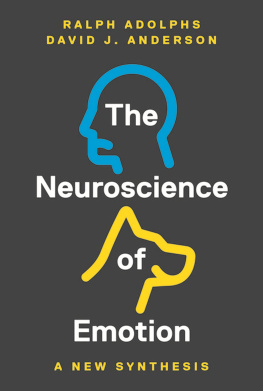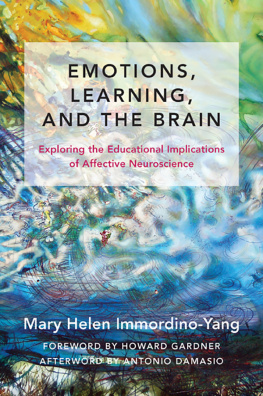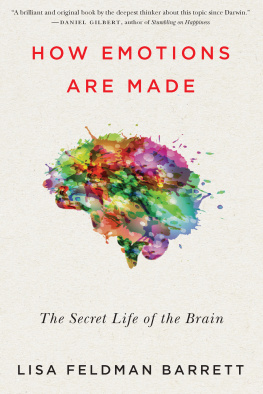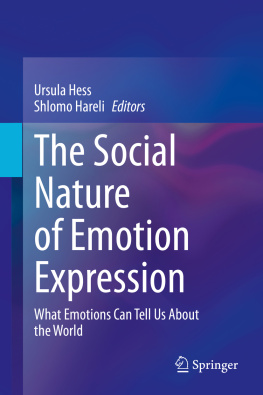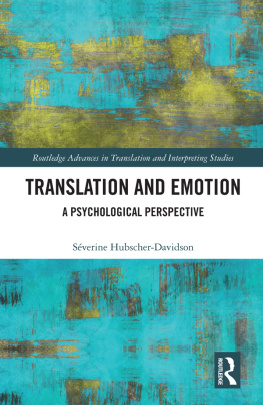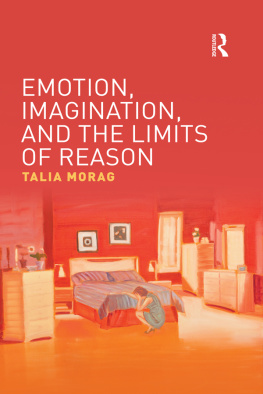Tavola dei Contenuti - "TOC"
Punti di riferimento

THE NEUROSCIENCE OF EMOTION
The
Neuroscience
of Emotion
A NEW SYNTHESIS
Ralph Adolphs and David J. Anderson
Princeton University PressPrinceton and Oxford
Copyright 2018 by Princeton University Press
Published by Princeton University Press
41 William Street, Princeton, New Jersey 08540
In the United Kingdom: Princeton University Press
6 Oxford Street, Woodstock, Oxfordshire OX20 1TR
press.princeton.edu
Jacket images courtesy of The Noun Project (thenounproject.com).
Human head icon (modified) by Gregor Cresnar.
Dog icon (modified) by Boris Farias.
All Rights Reserved
ISBN 978-0-691-17408-2
Library of Congress Control Number: 2018933553
British Library Cataloging-in-Publication Data is available
This book has been composed in Adobe Text Pro and Replica Pro
Printed on acid-free paper.
Printed in the United States of America
10 9 8 7 6 5 4 3 2 1
CONTENTS
CHAPTER 5. The Neurobiology of Emotion in Animals:
General Considerations |
Other Emotion States: Aggression and Anger |
ILLUSTRATIONS
PREFACE
Emotions are one of the most apparent and important aspects of our lives, yet have remained one of the most enigmatic to explain scientifically. On the one hand, nothing seems more obvious than that we and many other animals have emotions: we talk about emotions all the time, and they feature prominently in our literature, films, and other arts. On the other hand, the scientific study of emotions is a piecemeal and confused discipline, with some views advocating that we get rid of the word emotion altogether. If you ask scientists, even those in the field, what they mean by an emotion, you will either get no explanation at all or else several quite discrepant ones that seem to be referring to quite different phenomena. We aim to provide a fresh look at emotion from the perspective of biology, a perspective that can provide a foundation for the field from which to move forward in a productive, cross-disciplinary fashion.
Emotions and feelings have been the topic of countless books, some of them detailed technical books (often a collection of chapters from many different authors), and most of them popular books focused on the psychology of emotion. Ours is none of these. It is not intended as a textbook, a popular book, or a monograph of any sort. Instead, our aim in writing this book was to take stock of the field, from a fairly high-level perspective, to provide a survey of the neurobiology of emotion, and, most importantly, to provide both a conceptual framework and ideas for approaches that could be used by a neuroscience of emotion going forward. Our intended audience is any educated reader, but our core audience is students and researchers who are contemplating going into the field of affective neuroscience, or who are already in the field and wondering what path their research should take. We also hope that at least a good part of the book would be accessible and interesting to readers who do not have a strong scientific background. Indeed, it is entirely possible to glean most of the conceptual framework just from reading of the papers behind every point and study that we describe, instead choosing to give a more broadly accessible treatment that only cites the most important key papers or reviews (which, in turn, will provide interested readers with a longer list of further references).
Our book differs from most other books on emotion in scope and organization. One of us (Adolphs) investigates emotion in humans; the other (Anderson) investigates emotion in mice and flies. This breadth of different backgrounds, and the presentation of the different species studied, is a critical ingredient of this book, since it forced us to abstract from many details in order to uncover fundamental principles that would cut across different approaches and different species. It also meant that neither one of us is in fact the authority for all of the book: notwithstanding extensive discussions, comments, and cowriting, there are parts of the book that have only one of us as the principal author and expert. Indeed, there are parts of the book on which we continue to disagree!
We do not intend to provide a comprehensive new theory of emotion. Indeed, we dont feel that we provide any kind of theory of emotion at all. Instead, we describe ways that scientists should think about emotion, and ways that they should use the word emotion consistently in their science, in order to forge a neuroscience of emotion with the maximal long-lasting impact. Our intent was to provide a framework for investigating emotions that would be applicable to those working in animal models; those working with human subjects; those using functional magnetic resonance imaging (fMRI), electrophysiology, optogenetics, or clinical populations. We even hope that what we have written here would be useful to engineers who are trying to figure out how to build robots that have emotions. In our view, a science of emotion needs to meet two criteria: it should be comprehensive and it should be cumulative.
Forging a comprehensive science means that the encapsulation often evident in papers, journals, and meetings on emotion needs to be overcome. Scientists studying emotion in rats and in humans need to be able to speak to one another, rather than build walls that isolate their research enterprise from the rest. A comprehensive science of emotion also needs to connect with all domains of science that are relevant to .
A high-quality science of emotion requires not only clear terminology and operationalization of concepts, it also requires sensitive measures, statistically robust analysis tools, and creative hypotheses. The later chapters take up these issues in the context of a survey of ongoing neuroscience studies. Taken together, these ingredients would enable a cumulative science of emotion, a science in which current studies can build on prior work, and in which the accumulation of many studies over time allows comparisons and contrasts, as well as syntheses and formal meta-analyses. We are currently a long way from having achieved this. Indeed, most meta-analyses of emotion are either extremely narrow, or else hopelessly inconclusive because they mix studies with very different standards or terms.
There is no question in our minds that emotions are real phenomena that need to be explained. We believe that, in addition to humans, many other animals have emotionsboth of the authors of this book have cats as pets, and we are convinced that they have emotions. However, intuition and belief are not the same as scientific knowledge, and an important goal of the book is to suggest objective criteria to apply in searching for cases of emotional expression in animals. Finally, we also believe that emotions are states of the brain, and that the mechanisms that generate emotions can be investigated with neurobiology. Our book is based on these underlying assumptions; we summarize them again in the very last chapter.
ACKNOWLEDGMENTS
We thank Daniel Andler, Lisa Feldman Barrett, Andrea Choe, Antonio Damasio, Karen DiConcetto, Frederick Eberhardt, Yanting Han, Prabhat Kunwar, Joseph LeDoux, Uri Maoz, Aaron Mendelowitz, Leonard Mlodinow, Amanda Nili, Oana Tudusciuc and Moriel Zelikowsky for helpful comments and discussion on drafts of the book.
Special thanks are due to Len Mlodinow and Amanda Nili, who provided detailed edits on parts of the book; to Anna Skomorovsky, who made most of the figures; to Yuki Toy, who created sketches of humans and animals; and to Sheryl Cobb, who obtained copyright permissions. We are grateful to Dawn Hall for expert copyediting, and to Alison Kalett and the staff of Princeton University Press for their comprehensive support in all aspects of production and marketing.

